|
Springbrook, the wet heart of the Gondwana Rainforests of Australia, preserves outstanding examples of ecosystems and taxa from which modern plants and animals are derived, including
- some of the oldest elements of the world's ferns from the Carboniferous period,
- one of the most significant centres of survival for the Southern Conifer family, Araucariaceae, probably the oldest living conifers
- an outstanding record of flowering plants (Angiosperms),
- an outstanding number of the oldest lineages of the Corvida, one of the two major groups of true songbirds which evolved in the Late Cretaceous (>65 million years ago), and
- outstanding examples of other relict vertebrate and invertebrate fauna from ancient lineages linked to the break-up of Gondwana.
Some of the more outstanding animals and plants contributing to Springbrook’s World Heritage values are described below.
Albert’s Lyrebird (Menura alberti)
Evidence from DNA studies show lyrebirds, scrub-birds, treecreepers and bowerbirds, all of which evolved on the Australian landmass, to be the most ancient of the world’s songbirds. So, the world’s songbirds had their origins in Australia many millions of years ago.
Lyrebirds and scrub-birds are the oldest line of songbirds still surviving.
Lyrebirds are renowned mimics, not only mimicking other birds but also human-produced sounds such as car tyres on gravel, alarms and chain saws. |
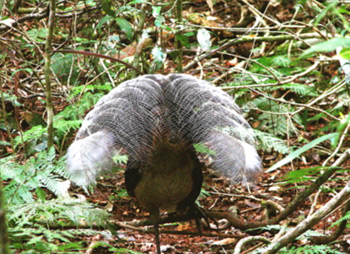 Photo: Kimbal Curtis
Photo: Kimbal Curtis |
Rufous Scrub-bird (Atrichornis rufescens)
As noted above, scrub-birds and lyrebirds are the oldest line of songbirds in the world. As for lyrebirds, there are just two species of scrub-bird, Rufous and Noisy, with the latter occurring only in the southwest corner of Western Australia. The scrub-birds are so different from other birds that, like lyrebirds, they are placed in their own family. So, the only two species in the family are separated by 3500 kilometres! |
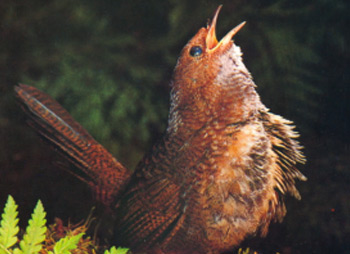 Photo: Michael Morcombe
Photo: Michael Morcombe |
Logrunner (Orthonyx temminckii)
Logrunners evolved on the Australian landmass more than 25 million years ago. Fossils found at Riversleigh in northwestern Queensland and in cave deposits in Victoria and South Australia indicate they were widespread across eastern Australia at a time when it was covered with rainforest. As rainforest contracted, so too did the logrunners and today they are found only in central eastern Australia and New Guinea with another species in the genus, the Chowchilla, found only in the Wet Tropics of Queensland. |
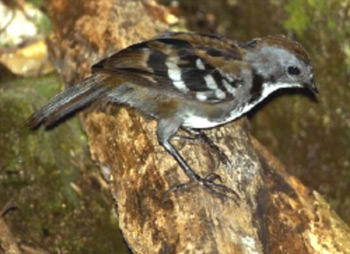
Photo: David Pavlacky |
Bowerbirds
Satin Bowerbird (Ptilonorhynchus violaceus)
Regent Bowerbird (Sericulus chrysocephalus)
As noted above, bowerbirds belong to an ancient line of songbirds. Bowerbirds, found only in Australia and New Guinea, are the only birds in the world to decorate their courting bowers. They are long-lived, surviving for up to 40 years.
The male Satin Bowerbird has a preference for the colour blue and paints his bower with blue pigment and decorates the surrounds with blue objects such as fruit and flowers. Some males also use human accessories such as clothes pegs and bottle caps for bower decoration, but this has been identified as not attracting females.
The Regent Bowerbird is generally restricted to the higher altitudes. Young male Regent Bowerbirds may take 7 years to adopt full male plumage |
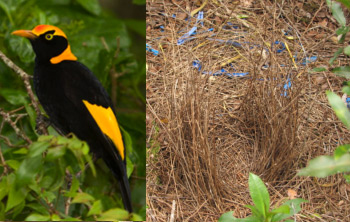
Photo: Mark Ash |
Photo: Aila Keto |
|
Green Catbird (Ailuroedus crassirostris)
The Green Catbird is a bowerbird (belongs to the bowerbird family) but does not build a courting bower. They mainly inhabit subtropical rainforest and their presence is readily detected by their childlike crying song or cat-like wailing.
Catbirds are mainly frugivores eating a wide range of fruits but also flowers, buds, leaves, stems and seeds. They are monogamous and form long-term pair bonds and are sedentary and territorial, defending a long-term territory of about 1 to 2 hectares. |
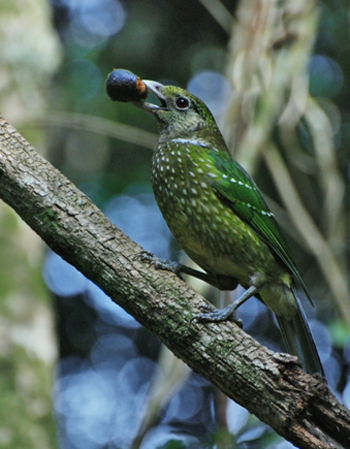 Photo: Chris.Kookaburra (flickr.com) Photo: Chris.Kookaburra (flickr.com)
|
Southern Angle-headed Dragon (Hypsilurus spinipes)
There are just two species of Hypsilurus in Australia. Boyd’s Forest Dragon (Hypsilurus boydii) is found only in the Wet Tropics of Queensland, while the Southern Angle-headed Dragon occurs in rainforests in southeastern Queensland and northeastern New South Wales.
There is debate about the origins of Hypsilurus. While there is agreement that it is of Gondwanan origin, it has been suggested by some authors that it arose in Australia and spread to New Guinea and adjoining areas while others suggest it entered Australia from the north. |
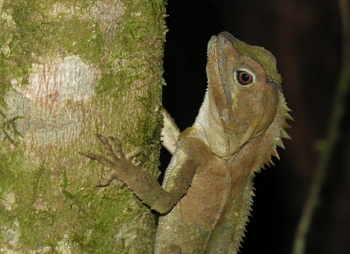 Photo: Mark Ash
Photo: Mark Ash |
Loveridge’s Frog or Masked Mountain Frog (Kyarranus loveridgei)
Loveridge’s Frog is found only in high-altitude rainforests (above 750 metres) on the McPherson Range in southeast Queensland and across the border in far northeast New South Wales. A rare, relatively small frog, it breeds its young in flask-shaped burrows in soft soil or in mossy cavities beside streams.
Fossils of Kyarranus have been found in deposits at Riversleigh, indicating their ancient origins and widespread occurrence when rainforests covered the continent. |
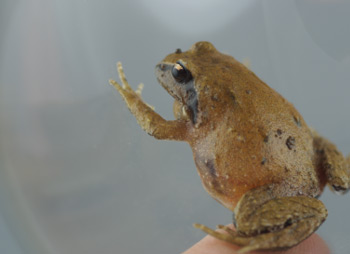
Photo: Keith Scott & Aila Keto |
Marsupial or Hip-pocket Frog (Assa darlingtoni)
The Marsupial Frog is a rare species found only in high-altitude rainforests on the McPherson Range in southeast Queensland and the adjoining Border Ranges area in New South Wales. It is almost unique in raising its young in ‘pockets’ on its flanks. Its nearest relative is in South America, indicating its Gondwanan origin.
It is not only rare among frogs for the parents to look after their young, but is also rare within the animal kingdom for the male to have sole responsibility for parenting. |
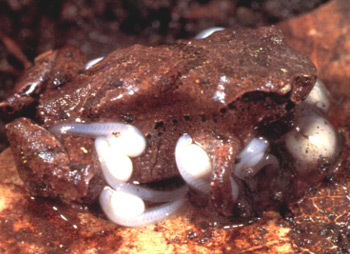 Photo: H. Ehmann
Photo: H. Ehmann |
Lamington Blue Spiny Crayfish (Euastacus sulcatus)
Euastacus belongs to a family of freshwater crayfish found only in eastern Australia and South America indicating its likely Gondwanan origins.
Apart from this species, there are two other species, Euastacus maidae and Euastacus valentulus recorded from Springbrook National Park.
Euastacus maidae is listed as endangered in the IUCN Red List though the listing may need updating. |
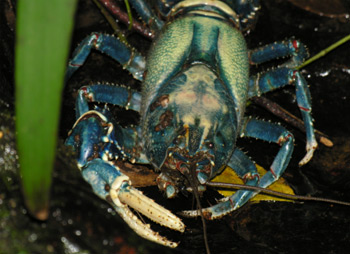 Photo: Mark Ash
Photo: Mark Ash |
Tasmannia insipida, Brush Pepperbush (Winteraceae)
Tasmannia insipida occurs in rainforests along the east coast of Australia. The fruit are berries that vary in colour from white to purple to black. The common name is based on the use of the seeds as a spice.
The Winteraceae retain primitive characteristics indicating their ancient origins.
“closest to ancestral stock of flowering plants” |
|
Eupomatia bennettii Small Bolwarra (Eupomatiaceae)
Eupomatia laurina Bolwarra (Eupomatiaceae)
The Eupomatiaceae have a basal position in the evolution of flowering plants. This ancient family consists of just one genus with three species and occurs only in Eastern Australia and New Guinea.
Eupomatia species are pollinated exclusively by tiny weevils in the genus Elleschodes. Beetle pollination is common in primitive flowering plants and, as is the case in Eupomatia, involves special flower parts called ‘staminodes’ that reduce self-pollination (benefiting the plants) while providing a food source for the weevils. Weevils are attracted by the very strong and distinctive fragrance emitted by the flowers. The staminodes are stamen-like but produce no pollen. In Eupomatia and other primitive flowering plants, they produce sticky secretions, odoriferous oils and provide both food and shelter for pollinating beetles. They represent an extraordinary specialization in primitive flower types and have no counterpart in more advanced flowering plants. |
|
|
Wilkiea austroqueenslandica (Monimiaceae)
This plant occurs predominantly on remnants of the Mt Warning shield volcano, extending north to Mt Tamborine and east to Burleigh Heads. The Monimiaceae are among the most ancient of flowering plants.
Wilkiea species are host plants for the uncommon Regent Skipper butterfly (Euschemon rafflesia). The Regent Skipper, found only in eastern Australia, is unique among butterflies in having structures that lock the fore-and hind-wings together in flight. This locking mechanism is a characteristic of moths, hence the speculation that the Regent Skipper is a link between butterflies and moths from they evolved. It also rests with its wings flat, a behaviour more characteristic of moths than butterflies. |
|
Eucryphia jinksii (Cunoniaceae) Springbrook Pinkwood
Endangered. This very rare tree occurs at just a few locations in rainforest at Springbrook and across the border in Numinbah Nature Reserve. The story of Eucryphia is extraordinary. The genus was previously known from 5 species, two endemic to Chile and 3 endemic to temperate rainforests in southern Australia. This distribution demonstrated the ancient Gondwanan origins of the genus. Nearly 40 years ago, a new species was recognised, amazingly, in tropical North Queensland. It was, however, not described until 1996. Botanists Paul Forster and Bernie Hyland formally described not only the North Queensland species, Eucryphia wilkiei, but also the Springbrook species discovered in 1994 by Springbrook botanist, David Jinks.
Eucryphia had been regarded as a genus of temperate forests. Hence, the discoveries in tropical and subtropical forests were more than surprising. Forster and Hyland note that the forest types in which these two species occur are floristically similar to those of southern types and that weather conditions are also similar.
Eucryphia jinksii and Eucryphia wilkiei must be regarded as relict species that are “persisting in narrow ecological niches in otherwise unsuitable climatic zones”. |
|
Nothofagus moorei, Antarctic Beech (Nothofagaceae)
The Southern Beech family evolved around 90 million years ago in Gondwana. It is today found widely dispersed but only on fragments of the Gondwanan land mass, in South America, Australia, New Caledonia, New Zealand and New Guinea.
Individual plants may be very old as it commonly coppices from the one root mass. |
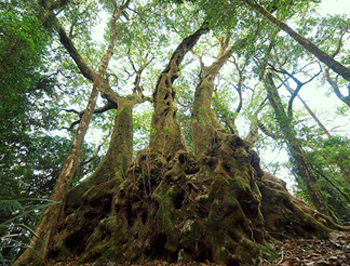 Antarctic Beech, Nothofagus moorei, in cool temperate rainforest Antarctic Beech, Nothofagus moorei, in cool temperate rainforest
© Lui Weber lui.weber@gmail.com |
Carronia multisepalea (Menispermaceae) Carronia
This uncommon woody climber is largely restricted to the remnants of the Mt Warning shield volcano with disjunct populations in the Blackall Range and Bellthorpe.
There are just three other species in the genus Carronia, two in the Wet Tropics of Queensland and one in New Guinea, indicating a formerly much wider occurrence when rainforests were widespread in Australia.
Around the world, moths belonging to the subfamily Catocalinae feed on members of the Menispermaceae. Carronia multisepalea is the host plant for caterpillars of the endangered southern subspecies of the Pink Underwing Moth (Phyllodes imperialis). The northern subspecies in the Wet Tropics feeds on another member of the Menispermaceae, Pycnarrhena novoguineensis.
Menispermaceae, the primarily tropical, basal-most and largest family within the order Ranunculales, was a conspicuous component of the early Australian rainforests that reached their peak during the Early Eocene (the Golden Era of rainforests. Queensland’s present-day rainforests are exceptionally rich in relict narrowly restricted genera of the Menispermaceae (almost 20 per cent of all genera in the family), the continental scale disjunctions of which reflect this long evolutionary history in East Gondwana.
|
|
Alloxylon pinnatum (Proteaceae) Tree Waratah
There are just four species in this genus, three endemic to eastern Australia and one to New Guinea. Two of the Australian species are restricted to the Queensland Wet Tropics, one occurring only on Atherton Tableland. Alloxylon pinnatum occurs from the McPherson Range to Dorrigo in northeast New South Wales at altitudes above 700 metres.
The Proteales is a key basal angiosperm order with Gondwanan origins. It is represented in Australia by the Proteaceae which has recently been recognised as basal to the two Northern Hemisphere families. The Proteaceae have the most extensive fossil record in the Southern Hemisphere of any taxonomic group. There are 4-6 subfamilies and the greatest diversity of subfamilies occurs in Australia, particularly in Queensland which also has the greatest diversity in Australia at the generic level.
The Springbrook region contains 22 species in 14 genera from three subfamilies and nine of the 15 tribes of Proteaceae.
|
|
The World Heritage values include:
- rainforests which are exceptionally rich in primitive and relict species, many of which are similar to fossils from Gondwana;
- subtropical rainforest habitat;
- warm temperate rainforest habitat;
- ancient ferns and tree ferns;
- conifers (e.g. hoop pine) and cycads;
- primitive groups within Magnoliales and Laurales (e.g. pepper bushes, sassafras, Trimenia, Wilkiea, Cryptocarya, Litsea);
- primitive groups within Rosidae and Dillenidae (e.g. coachwood, Antarctic Beech, Eucryphia jinksii, turnipwood, Pittosporum, most common in warm temperate and subtropical rainforest types);
- primitive group of Corvida (such as lyrebirds, rufous scrub-bird, bowerbirds and tree-creepers);
- other birds dating from Gondwana (e.g. logrunner, thornbills, scrubwrens and gerygones);
- frogs in the families Myobatrachidae and Hylidae;
- reptiles such as chelid turtles, leaf-tailed gecko and angle-headed dragon;
- monotremes and marsupials; and
- invertebrate fauna with origins in Gondwana, including fresh-water crays, land snails, velvet worms, mygalomorph spiders, flightless carabid beetles, bird-wing butterfly and glow-worms.
- ecosystems and taxa which demonstrate the origins and rise to dominance of cold-adapted/dry-adapted flora, including:
- cool temperate rainforest habitat;
- dry rainforest habitat; and
- plant species in the families Myrtaceae, Casuarinaceae and Proteaceae
|
|

